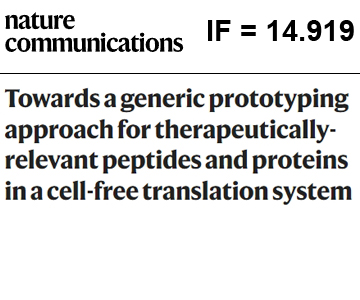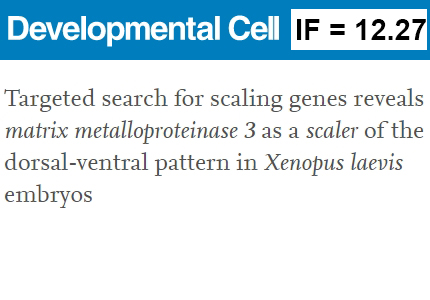Press-room / Digest

Towards a generic prototyping approach for therapeutically-relevant peptides and proteins in a cell-free translation system
Scientists from the Queensland University of Technology and the University of Queensland (Australia), with the participation of a member of the group of molecular tools for living system studies (IBCH), have developed a method that allows folding in vitro produced disulfide-rich peptides and proteins in an aggregation-free and thermodynamically controlled folding environment. To this end, we modify an E. coli-based in vitro translation system to allow co-translational capture of translated products by affinity matrix. This approach reduces aggregation of (poly) peptides and provides efficient oxidative folding under thermodynamic control. The developed approach can find application for prototyping a wide range of disulfide-constrained peptides, macrocyclic peptides with unnatural bonds, and antibody fragments in amounts sufficient for interaction analysis and biological activity assessment. The work was published in Nature Communications journal (IF 14.919).

Hypocrates is a genetically encoded fluorescent biosensor for (pseudo)hypohalous acids and their derivatives
The team from the Department of metabolism and redox biology together with Russian and foreign colleagues from Belgium and France, has developed a new analytical tool that allows registering (pseudo)hypohalous stress in living systems at subcellular resolution in real-time mode. The indicator was characterized in detail in vitro, and the spatial structure of a redox sensor based on a circularly permuted fluorescent protein was established for the first time. The resulting instrument was used to visualize the dynamics of active halogen species in the model of inflammation caused by the amputation of Danio rerio caudal fin. The work was published in Nature Communications journal. Learn more

Human Telomerase RNA Protein Encoded by Telomerase RNA is Involved in Metabolic Responses
Telomerase RNA is one of the core components of the telomerase complex and participates in survival mechanisms that are activated under stress conditions. Human telomerase RNA protein (hTERP) is encoded by telomerase RNA and has been recently shown to be involved in autophagy regulation. In this studya team of scientists from the Laboratory of Molecular Oncology of the IBCh RAS, MSU, and SRI PCM FMBA of Russia demonstrated the role of hTERP in the modulation of signaling pathways regulating autophagy, protein biosynthesis, and cell proliferation. The AMPK signaling pathway was affected in cells deficient of hTERP and when hTERP was overexpressed. The appearance of hTERP is important for metabolism switching associated with the accelerated proliferation of cells in healthy and pathological processes. These findings demonstrate the connection between telomerase RNA biogenesis and function and signaling pathways. The results are published in the Frontiers in Cell and Developmental Biology journal.

Scalers: genes that regulate scale invariance of embryonic development
Embryos of many organisms are able to maintain the invariance of their structure, regardless of size – the so-called phenomenon of embryonic scaling. For example, embryos of sea urchin or frog, which have developed from individual cells isolated shortly after the beginning of egg cleavage, self-regulate their structure so that they appear as smaller copies of normal ones. Researchers at the Laboratory of Molecular Bases of Embryogenesis at the IBCH RAS have proposed a general approach to the study of the mechanisms of embryonic scaling. They heuristically postulated and then mathematically proved the existence of special genes, named scalers, the expression of which depends on the embryo size, developed a method for targeted search of such genes, and, as proof of principle, disclose the mechanism by means of which one of the found scalers, mmp3, regulates patterning of Xenopus laevis embryo in a size-dependent manner. This work was published in the Developmental Cell journal. Learn more

FLIM-Based Intracellular and Extracellular pH Measurements Using Genetically Encoded pH Sensor
Researchers from the Institute of Bioorganic Chemistry, Russian Academy of Sciences, from the Laboratory of Receptor Cell Biology, Laboratory of Molecular Theranostics and the Group of Molecular Physiology, together with colleagues from the I Prokhorov General Physics Institute and Moscow State University, a genetically encoded fluorescent sensor for measuring the pH of the extracellular medium in the slightly alkaline range has been created. To accomplish this task, a number of chimeric proteins were obtained, which are the previously described pH sensor SypHer3s with different transmembrane domains: from CIRL2, ErBb2, TrkA, IR, and neurexin-1. Among these fusion proteins, only the variant with the transmembrane domain of neurexin-1 was localized on the cell membrane. This protein was named SypHerExtra. Using the method of fluorescence lifetime imaging microscopy (FLIM) on living tumor cells, it was demonstrated that SypHerExtra can be successfully used to determine extracellular pH, while SypHer3s can be used to measure intracellular pH. The results are published in the journal Biosensors. Learn more

